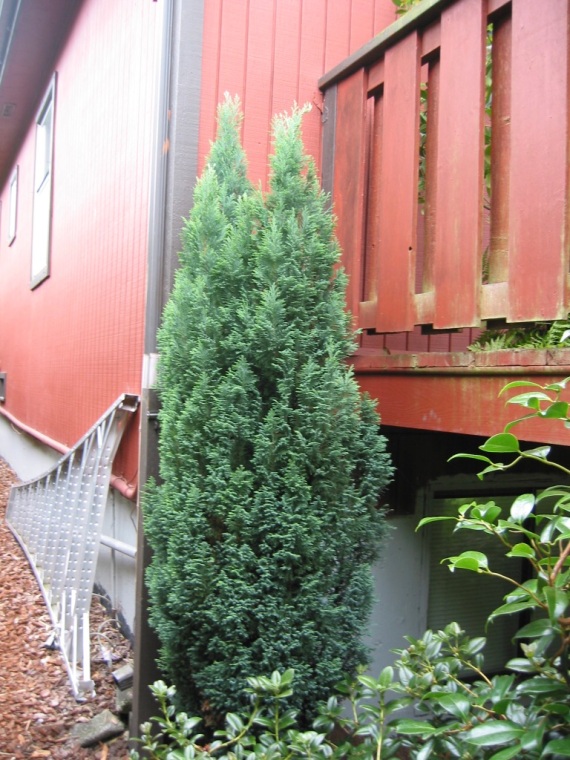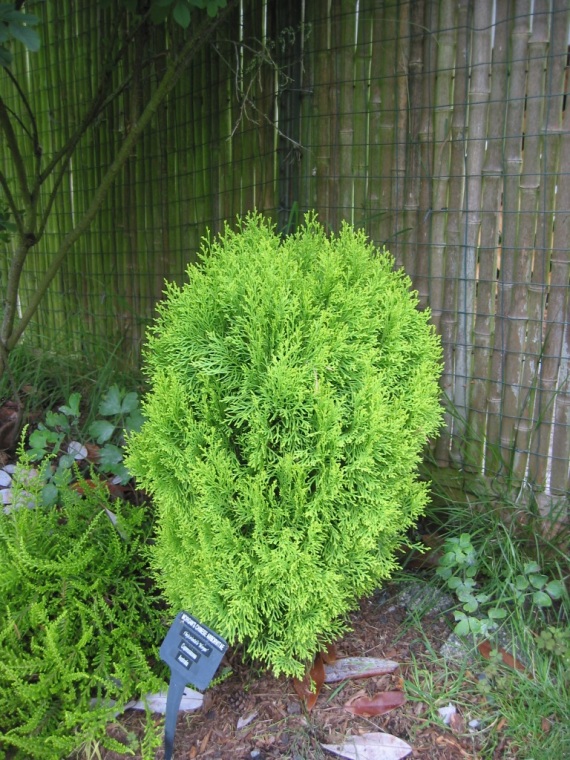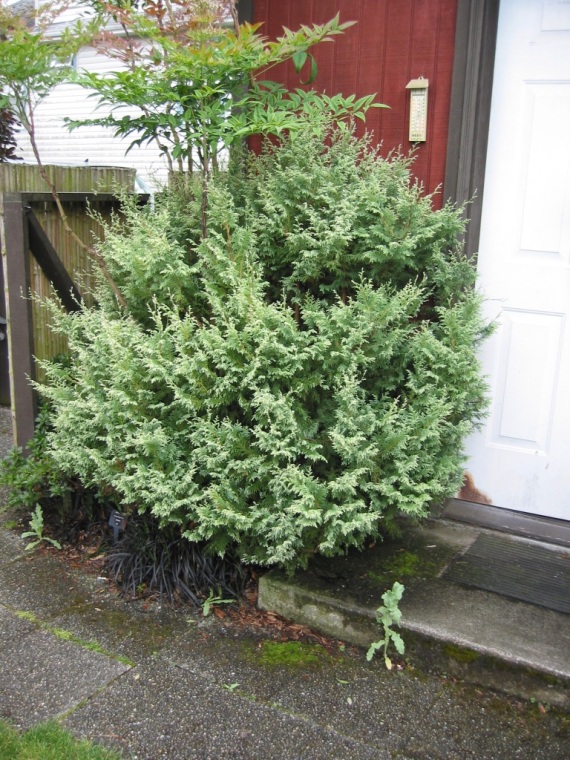Dwarf Alberta Spruce (Picea glauca var. albertiana f. conica)
All the conifers I’ll be showing you in this post are small ones that only grow up to 10′ tall. I love the little ones a lot. They take up little room so there’s space to plant several of them in small areas. Of course I have them all over the garden. These two have been growing here for over 35 years. Louie planted them long ago and they’ve gotten quite large in that time. They’ll get still bigger, but not more than 10′. Discovered in 1904 they are native to SW Canada and across the Northern US to Maine. You’ve probably seen these all over, as they are sold as christmas trees at holiday time. Naturally no one ever realizes just how large they get and are surprised when they outgrow their tiny planting spaces. Ah well… Live and learn…
Snow White Lawson Cypress (Chamaecyparis lawsoniana “Snow White”)
This is a dwarf form of the Lawson Cypress, or Port Orford Cedar, that grows in southern Oregon. The species tree is a large forest dweller that gets quite tall, but this one will only get 6 or 8′ tall. It’s 6 1/2′ now after about 10 years in the ground here. It’s soft and fluffy to the touch and is tinged with a light yellow white color in spring. One of my favorites.
Red Star Atlantic White Cedar (Chamaecyparis thyoides “Red Star”, aka “Rubicon”)
We jump across the United States from the last one with this Red Star False Cypress. I just planted this a few months ago and it’s still very small, but it will get 4-5′ tall in time (some people say much larger, but who knows…). Its blue green juvenile foliage turns a warm red purple in winter and is quite lovely. A slow grower, it will take years to achieve its full size.
Mr Bowling Ball Arborvitae (Thuja occidentals “Bobozam”)
Where do they get these names anyway? Doesn’t look much like a bowling ball to me, and I don’t have a clue why it’s called Bobozam, but it’s kind of a cool name. Native to the NE United States and SE Canada it has filiferous foliage that turns this lovely light color in winter, when this photo was taken. It’s green now. It might become a 3′ ball, but it will take awhile.
“Grune Kugel” Western Red Cedar (Thuja plicata “Grune Kugel”)
This is a dwarf form of the signature PNW tree – the mighty Western Red Cedar. This special tree was used by the indigenous people for just about everything. They made buildings and canoes of it, used it for basketry, and used it in ceremonies. It was the “buffalo” of the Northwest, as far as its utility to the native people goes. It will take it years to become much more than a 2′ ball. It always amazes me to see a small dwarf form of a huge tree. Trees do such incredible things!
Blue Star Juniper (Juniperus squamata “Blue Star”)
A very slow growing juniper with a lovely bluish color to it that looks great next to its neighbors. It’s a nice contrast at the front of the garden as you view it from the house. It will never get very big – maybe 2-3′ x 3-5′ in a long time. I’ve heard they look ugly when they get old but this one is 10 years here and still looks great to me. I expect it to stay nice for years.
Spreading English Yew (Taxus baccata “Repandens”)
Slow and elegant looking, this dwarf English yew is native to many parts of Europe and Asia. The main species tree is well known in old churchyards in England, which I saw for myself back in the late 60’s when I was there. This will only get 3-5′ tall and 4-7′ wide, but I have to keep it gently pruned to keep it in its space here. 10 years have gotten it to this size.
Amersfoort English Yew (Taxus baccata “Amersfoort”)
This is a rare one, that many people think may be a cross between English and Japanese Yew, but they call it English, for now anyway. It’s kind of weird looking, almost reptilian. I have to carefully remove the new growth in late spring every year to keep it from attaining its full size of 5 – 8′. It’s next to the fountain and I want to be able to see the fountain from the house so I keep it low. Yews take to pruning very well and it always comes back great. It was found on the grounds of the Amersfoort Insane Asylum in Holland and some wits in the nursery trade describe it as “one crazy plant”. Whatever…
Elegans Nana Sugi (Cryptomeria japonica “Elegans Nana”)
Sugi is the Japanese name for Cryptomeria, or Japanese Cedar (tho it’s not a true cedar). The large species tree is the national tree of Japan. I love the way this looks like a mop headed Sesame Street character. It’s pretty slow growing and has taken 8 years or so to get this size. There’s a full size Elegans next to it and they look similar but also quite different. There are several hundred cultivars of Cryptomeria, from dwarves only a foot tall to trees over 150′. A very versatile tree.
“Kelly’s Prostrate” Coast Redwood (Sequoia sempervirens “Kelly’s Prostrate”)
It’s hard to believe that this is the tallest tree in the world, maxing out at over 365′ tall! This is a very dwarf form that is now only 2 1/2′ tall and about 7-8′ across. It grows pretty fast and has been here for a good 9 years now. I got it in a 10 gallon can that was very big when I planted it, but it’s gotten way bigger since then. Native to the California and N. Oregon coast.
Tansu Sugi (Cryptomeria japonica “Tansu”)
Another Japanese Cedar, this is one of the smallest ones. In 10 years it’s still less than 2′ around. It’s grown very slowly to get even this big and will never get a lot bigger. It’s a bit prickly to the touch but I love the craggy mountainous look of it.
Alpine Yew Pine (Podocarpus alpinus (“Red Tip”)
Native to Australia and Tasmania this is called Red Tip because the tips of the branches turn a deep purple red in late spring. It looks very nice when the color is on it. I don’t have many plants from the Southern Hemisphere, but I have a few, like this one here. Most podocarpus are native to Asia and some are large trees, but this will never get more than 4′ or so.
“Ryokogo Coyokyu” Sugi (Cryptomeria japonica “Ryokogo Coyokyu”)
Also called Green Jewel Dragon, a much more interesting name than the botanical one, this is another very small Japanese Cedar. It looks a little like the Tansu in that they both look like small craggy mountains and grow very slowly. This one puts on about 1/16″ per year. You can barely see it grow. The tips turn a nice reddish color in the winter.
Japanese Plum Yew (Cephalotaxus harringtonia “Fastigiata”)
Not a yew at all, this is actually in the Cephalotaxaceae family. (say that fast three times…) It’s a very narrow plant, only getting 2-3′ wide but close to 10′ tall in many years. This has been here for 9 years and has put on a foot of growth every year. I’m very fond of it, but had a hard time shooting it. I had to stand on the deck above it to get the whole thing.
Wissel’s Saguaro False Cypress (Chamaecyparis lawsoniana “Wissel’s Saguaro”)
This may actually grow to over 10′, but it seems no one really knows how big it will get. It’s called the Saguaro because it looks so much like the famous Saguaro cactus in the desserts of Southern California. The tree is a form of the Lawson Cypress I mentioned earlier. This mad cap form was developed in Holland, or maybe it was just “found”, I’m not sure. Planted at the entrance to our house, it’s a very cool plant to greet our visitors.
Baby Blue Sawara Cypress (Chamaecyparis pisifera “Baby Blue”)
When I planted this it was a 1 1/2′ ball, but over the last 10 years it’s turned into a very nice cone shaped small tree. It may get somewhat taller but not a lot. It’s a little over 6′ now and is one of the softest plants we have. I love to “pet” it. The blue makes a nice contrast to the surrounding plants and gives a bit of color, besides green!, to the back garden area.
Nana Hinoki Cypress (Chamaecyparis obtusa “Nana”)
Supposedly one of the smallest forms of the Hinoki Cypress, or Fire Tree, this is native to Japan. The species tree is used for building temples and ceremonial purposes there, and is considered a sacred tree. As with Cryptomeria there are literally hundreds of cultivars of Hinoki Cypress. The species is a tall forest tree, but the cultivars range down from there to this one.
Graciosa Hinoki Cypress (Chamaecyparis obtusa “Graciosa”)
We just planted this one in February after we had “snowmageddon” here that dropped a couple of feet of snow on the Seattle area and destroyed the large arborvitae we had here. It was tragic, but we took it out and re-made the whole area. It looks really nice and open now, tho we lost our major privacy. It’ll come back tho, since this tree grows to become 8-10′ tall and 6-8′ wide. It grows a foot a year and is very soft to the touch and looks quite graceful – thus Graciosa.
Carstens Wintergold Mugo Pine (Pinus mugo “Carstens Wintergold”)
Mugo pines are small trees native to Europe. This cultivar was created/found in 1988 in Germany. It turns this gorgeous golden color in winter, but in spring it reverts back to a plain old green mugo pine. It only grows 2″ a year so it will stay in this pot for quite some time. It needs sun to change color well so I’ll have to move it soon so it gets enough by fall.
Morgan’s Chinese Arborvitae (Thuja orientalis “Morgan”)
I don’t have a clue why they call this “Chinese” since it comes from Australia, another one from the Southern Hemisphere. It’s a wonderful plant for color that turns purple in the fall, warm orange/brown in winter and then this fine lime green in summer. I had to site it in a sunny spot so it would change color. This place seems to work just fine for that.
Chirimen Hinoki False Cypress (Chamaecyparis obtusa “Chirimen”)
Chirimen is a type of crinkly kimono fabric that gives its name to this unique plant. It grows very slowly and only gets 4′ tall and not very wide, as you can see. I pruned off the inner foliage some years ago and kinda wish I hadn’t, but it still looks OK. It’s in a very shady spot and does just fine there.
Snow Sawara False Cypress (Chamaecyparis pisifera “Snow”)
This is the same tree as the Baby Blue I showed you earlier. The tips of the plant turn this lovely whitish color as they grow, even in the full shade it’s in. The American Conifer Society tag on it said it would only get 16″ tall!! Huh?? I saw one in a botanical garden that was 4′-5′ around. I’ve had to carefully prune it so it will still fit here. Very soft and elegant.
That’s it! All the little ones. I have so many more conifers to show you, but I figured I’d limit it by size this time. As I said, none of these is supposed to get even 10′ tall, tho some come very close to that, as I’ve mentioned in the commentaries. I’m a big fan of conifers and these 22 plants are just a small sampling of all the conifers in general here in our little Nature Sanctuary. Conifers can be enjoyed all year round with their evergreen, or blue, or gold, foliage. They form the backbones of many gardens and offer a great deal of stability. I love them, as you can probably tell!
Evergreenly yours,
Steve























